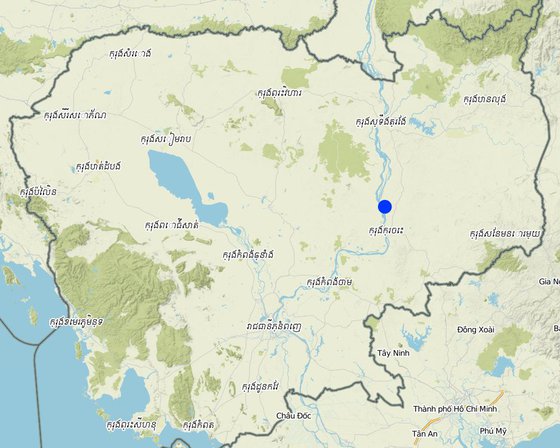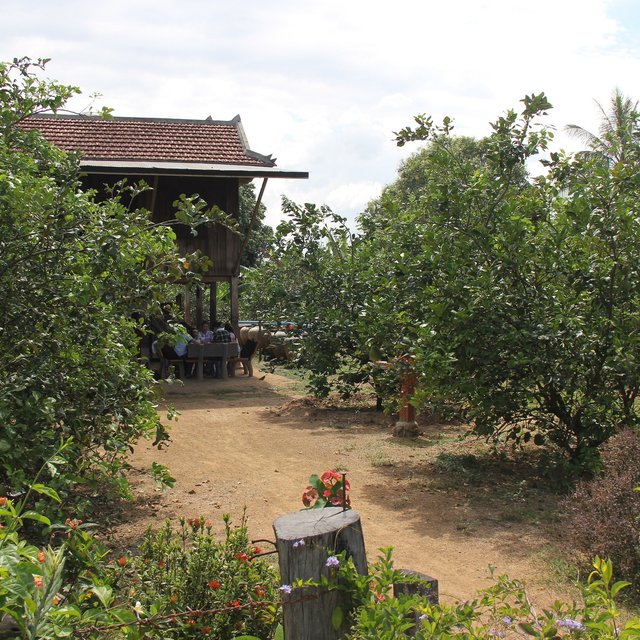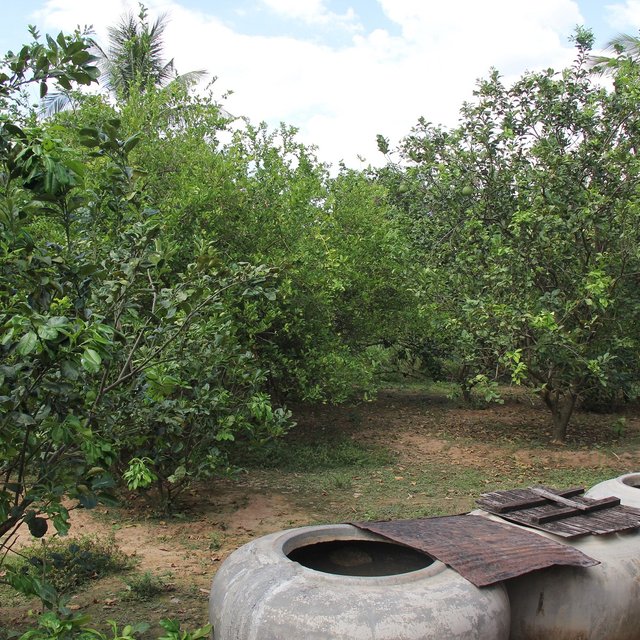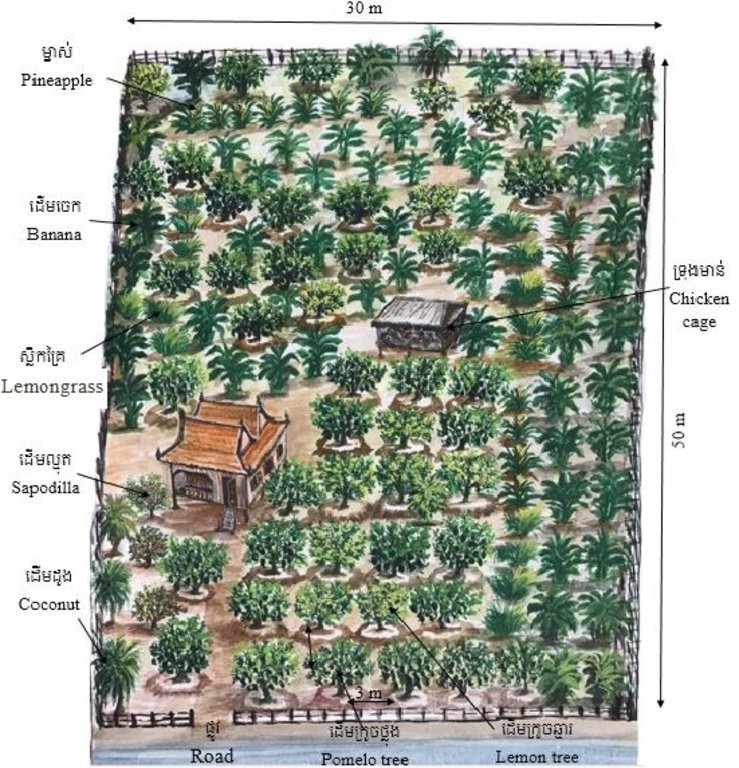



A home garden is the practice of planting different crops around the house such as a variety of vegetables, herbs, fruit trees, and other annual crops for the family’s daily consumption as well as for commercial purposes. Home gardens have been set up in Cambodia and in many countries all over the world, albeit they might be named differently (Helen Keller International/Cambodia., 2003). This technique provides both economic and environmental benefits: generating household incomes and regulating the micro-climate by creating a desirable and ambient temperature around the house which makes the lives of family members more comfortable. More importantly, the technology provides opportunities for marginal groups like women, children, aging people and the disabled, to carry out agricultural work that contributes to an increase in household income (Landon-Lane C., 2012; Helen Keller International, 2010).
Home garden technique is being applied at Samraong village, Sambour commune, Sambour district, Kratie province, where the farmer is growing pomelo (30 trees) and lemon (10 trees) as the main crops for sale and other supplementary crops (banana, pineapple, pomegranate, lemongrass, coconut, mango and jackfruit mainly for household consumption. The technology is being implemented in an area of 1500 square meters (30x50 meters), with the Mekong River being located behind the house.
In order to plant the pomelo and lemon trees, the farmer digs 0.6 x 0.6 meter square pits that are 0.5 meters in depth. There is a distance of three meters from one pit to another to allow ample space for the trees to fully spread their branches. Animal manure is also added into the bottom of the pits. In addition, the farmer builds a small circular dike around the trunk of each pomelo and lemon tree in order to avoid water run-off while watering, and furthermore this can retain some water during rainfall. This technology only applies cattle and chicken manure, and avoids the use of chemical fertilizers.
Through the implementation of the home garden technology involving the cultivation of lemon and pomelo trees as the main produce as well as other supplementary crops, the farmer can gain many benefits. These include improving the farmer’s daily income, creating greenery around the house and providing a favorable living environment that can adapt to the rising temperature caused by climate change. Also the technology is preventing or addressing soil erosion, and providing an appropriate environment for poultry raising. This technology is not expensive as the farmers are able to start implementing it on a step by step basis depending on the availability of labor and resources or they are also able to do it during their spare time.
Farmers can harvest lemons on a daily basis (around 10 to 15 kg per day) and also other supplementary crops. The pomelo trees produce fruit once per year (around 30 fruits per tree on average). In addition, such crop diversification also creates a natural habitat for biodiversity underground, which is an important factor in enhancing soil nutrients and other aggregates. It also avoids the use of chemicals that could harm the health of the family.

Location: Village land, Samrorng Village, Sambo Commune, Sambo District, Kratie Province, Cambodia
No. of Technology sites analysed: single site
Spread of the Technology: evenly spread over an area (approx. < 0.1 km2 (10 ha))
In a permanently protected area?:
Date of implementation: 2010
Type of introduction







| Specify input | Unit | Quantity | Costs per Unit (Riel) | Total costs per input (Riel) | % of costs borne by land users |
| Labour | |||||
| Digging hole (own self) | day | 10.0 | 20000.0 | 200000.0 | 100.0 |
| Equipment | |||||
| Pumping machine and pipe | set | 1.0 | 2000000.0 | 2000000.0 | 100.0 |
| Hoe | piece | 4.0 | 20000.0 | 80000.0 | 100.0 |
| Shovel | piece | 1.0 | 15000.0 | 15000.0 | 100.0 |
| Basket | piece | 5.0 | 10000.0 | 50000.0 | 100.0 |
| Plant material | |||||
| Buy soil to fill | Small trucks | 100.0 | 25000.0 | 2500000.0 | 100.0 |
| Pomelo seedlings | Tree | 30.0 | 40000.0 | 1200000.0 | 100.0 |
| Lemon seedlings | Tree | 10.0 | 15000.0 | 150000.0 | 100.0 |
| Fertilizers and biocides | |||||
| Cattle Manure | Sack | 20.0 | 3000.0 | 60000.0 | 100.0 |
| Total costs for establishment of the Technology | 6'255'000.0 | ||||
| Total costs for establishment of the Technology in USD | 1'563.75 | ||||
| Specify input | Unit | Quantity | Costs per Unit (Riel) | Total costs per input (Riel) | % of costs borne by land users |
| Labour | |||||
| Put fertilizer (done by the farmer herself) | day | 10.0 | 20000.0 | 200000.0 | 100.0 |
| Weeding | times | 32.0 | 14000.0 | 448000.0 | 100.0 |
| Harvesting | hours | 635.0 | 2500.0 | 1587500.0 | 100.0 |
| Equipment | |||||
| Gasoline for pumping mechine | liters | 608.0 | 3000.0 | 1824000.0 | 100.0 |
| Fertilizers and biocides | |||||
| Manure | Sack | 30.0 | 3000.0 | 90000.0 | 100.0 |
| Total costs for maintenance of the Technology | 4'149'500.0 | ||||
| Total costs for maintenance of the Technology in USD | 1'037.38 | ||||
Increase around 20% if compare to previous productions of mango trees.
Crop quality of both pomelo and lemon are increase slightly because there are enough water if compared to other place.
Pomelo and lemon are higher demand that lead to increase household income by getting higher price.
The dike construction around tree trunks is keeping water for longer time.
Water irrigation still demanded because beside of pomelo and lemon she planted as other crop mango trees.
Not using pesticides
Additional profit of around 20%
Farmer received additional revenue after this practice
The workload has decreased because previously she irrigated by hand, but now she is using a pump machine.
She is obtainin higher yields
She does not use chemicals or other toxic elements at all.
The land user got knowledge about efficient water protection by dike construction around tree trunks and also about the positive effect of using of animal manure.
Because of dikes around the trunks that preserve water for longer time.
Has been reduced by using natural fertilizers (chicken and cattle manure).
Can be reduced by using natural fertilizers (chicken and cattle manure).
Increasing nutrition because plant leaves fall to the ground.
There is an increase as instead of chemical fertilizers animals manure is used.
Pest and disease are normal because this technique doesn't focus on that. And further there are no chemical or biotic fertilizers in use.